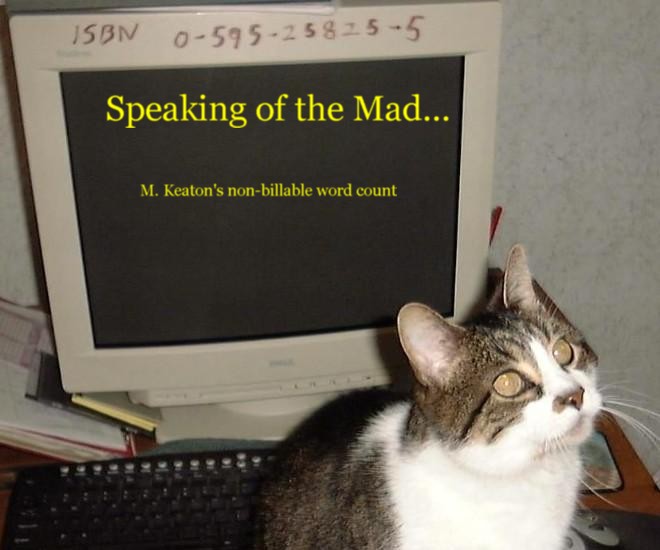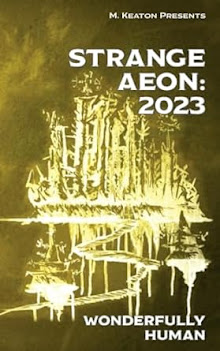Finally, I have badgered the Thin Man into condensing his Dark Matter notes into a (for him) coherent form and letting me put them on the weblog. (I told him we needed to be more contraversial to get more hits to which he nodded and said "My views on science will do it.")
The reason for Dark Matter as a first topic is simple. It was background research for a sci-fi/horror project that may or may not get off the ground. The project is on hold but I argued that we might as well use the research.
I now yield the podium to our esteemed...well, to the guy that feeds me.
"I ought to feed you to a dog."
"Boss, you're on already."
"Oh Vey!"
Before I get started on Dark Matter, and scientific topics in general, let me issue a few disclaimers right off the top. The first is that I am an ex-scientist. I say 'ex' because I'm now a full time writer but in truth I still am a scientist. I research my work very heavily and I try to stay current in my chosen field (nuclear chemistry). Prior to the collapse of my health, I was an analytic (environmental) analyst and, in time, took over the quality assurance program of the laboratory I worked at. I say all of this, not to brag, but to silence in advance any scurrilous attacks on my credibility or my ability to "understand the complexities of scientific theory and research."
Second, I should like to remind the reader that, as any author already knows, all synopses look silly. Any idea, be it book plot or scientific theory, stripped to its barest essence tends to appear foolish and shallow. That being said, some theories are silly. If it looks like a dumb idea, it probably is. Science is full of dumb ideas; we have to try them all—the silly and the respectable because science as a procedure is determined by observation, not public relations and sound bites.
Third (and this should probably be its own set of posts), science is a tool, not a worldview or religion. Many people, especially in the media but also in science, take it as a be all and end all and try to apply science to solve all problems. That's like trying to do titration with a hammer because one tool is as good as another but there it is. By definition, science the tool is based on reproducibility and predictive falsibility. Scientists from Hawkings to Holton have repeatedly pointed out that science is incompatible with unique phenomena such as beginnings and endings but this point is ignored by those who wish to use science as a replacement for religion and therefore extend science into metaphysics. (Side note: There is nothing wrong with the studies of metaphysics and pseudo-science. Many great scientific theories have originated in these two areas. There is no shame in either and yet, in our science worshiping society, every theorist insists that their work be regarded as "real science" instead of the equally valuable and properly termed metaphysics or pseudo-science. As always, through the history of science, ego is more important than proper protocol.)
Finally, I have a personal and long-standing grudge against cosmology. It is not a universal hatred of the subject nor its students. Indeed, I count Brother Guy Consolmagno as a dear brother in Christ and look forward to seeing him and hopefully doing panel discussions with him in the coming year at ConClave (if the powers that be see fit to have me back again). That being said, my problem with cosmology is three-fold: the overwhelming hubris of its practitioners (generally, not everyone of them) especially their insistence in engaging in metaphysics and pseudo-science while demanding to be treated with an almost religious reverence, the constant use of data mining and selective damning of data to validate prior claims rather than adjusting theory to fit observed facts, and the consistent invocation of circular assumptions.
(By circular assumptions, I refer to situations where, for example, one researcher makes tentative assumptions by necessity as a baseline for their work—such as taking as a given that the speed of light is a constant or that the age of the universe is in the trillions of years. A second researcher then takes the first worker's results, without examining the baseline assumptions behind them, assumes them as his givens, and then proceeded to "prove" the first researcher's necessary assumptions. If the two sets of work were compared and rendered down to their truest form, we would then have a total view something like this: Researcher One: Assuming that the moon is made of Styrofoam, I have investigated the topography of the lunar surface and concluded, based on cratering, that, if it is, then the moon is only a week old. Researcher Two: Since Researcher One, in his previous paper, demonstrated that the moon is only a week old, I have examined the extent to cratering on the lunar surface and must conclude that the moon must be made of Styrofoam.)
Having said all this, we'll continue on with a basic explanations of the latest theories on dark matter but I do encourage you to consider both the qualifications and biases of the source.
Next Time: Actual information!
Friday, January 9, 2009
Subscribe to:
Post Comments (Atom)





















No comments:
Post a Comment